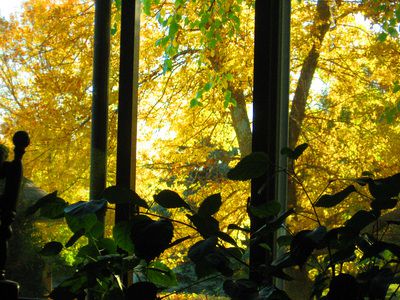Warm temperatures in October is pretty fun, as long as you don’t think too much about the wrongness of it all. It’s hit near 90 this week, which is simply not natural.
Check the current temperatures around the country:
Dallas 86
Orlando 86
New Orleans 82
St. Paul 81
Phoenix 71
Albuquerque 69
San Diego 65
The natives in Arizona hate the congestion caused by all the Minnesotans who seek refuge from the cold every winter. Maybe this winter, they’ll be coming here.
Meanwhile, the Associated Press reports that scientists are trying to figure out why autumn’s colors seem to be arriving later and later.
Scientists caution that heavy rain, drought-like conditions or temperature extremes can cause dramatic year-to-year fluctuations that don’t establish a long-term trend. For example, heavy rainfall in New England this spring, followed by a deluge caused by Irene, is causing fungal growth that’s causing some trees’ leaves to turn brown and drop earlier than normal.
William Ostrofsky, forest pathologist with the Maine Forest Service, is skeptical about whether there’s a proven link between fall foliage and climate change.
“I just don’t know that there’s any evidence to indicate there’s a trend one way or the other,” said Ostrofsky, who points out that year-to-year fluctuations make it difficult to discern long-term trends. “I really don’t think we’ve seen any long-term trend, as far as I can tell.”
The New York Times reported last week, however, that warmer-than-usual temperatures are wreaking havoc on trees, making them more susceptible to disease.
The writer of that story has a blog post online today in which he relays the half empty/half full nature of his observation:
When I was flying over Montana in a small plane with the scientist Steven W. Running, I was awed by the devastation we were seeing across one mountainside after another, and kept saying so. At one point, yelling over the engine roar, Dr. Running shut me up with a simple observation: “Look how much is left!”
His point was that the situation is not hopeless, and I came to see that he was right. I emphasize again, as I said in the article, that the forests of the world are continuing to take up a large amount of carbon. Even given all the problems we are seeing in the American West and in other affected regions, the healthy forests still outnumber the sick ones. Policies and action are needed to help them stay healthy, scientists say. So my answer to your question is: I just can’t bring myself to be that pessimistic.
True enough. But here in Minnesota, this scene, shot from the luxury of my couch this morning, accompanies a touch of sadness:
That’s an ash tree. If the experts are right, it’s only a matter of time before the emerald ash borer takes it and ends what passes for fall around many east metro suburbs, which are dominated by ash trees planted in the ’80s.
Nobody knows for sure how soon. Some residents aren’t waiting. They’re cutting down the trees now to get it over with. Some of us just sit on couches and wonder if this is the last time we’ll see such splendor, and silently think we’d gladly give up 80-degrees in October if an old-fashioned, kill-all-the-invasive-bugs, starting-early-never-ending winter would help keep the trees around awhile longer.

